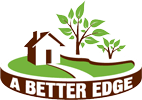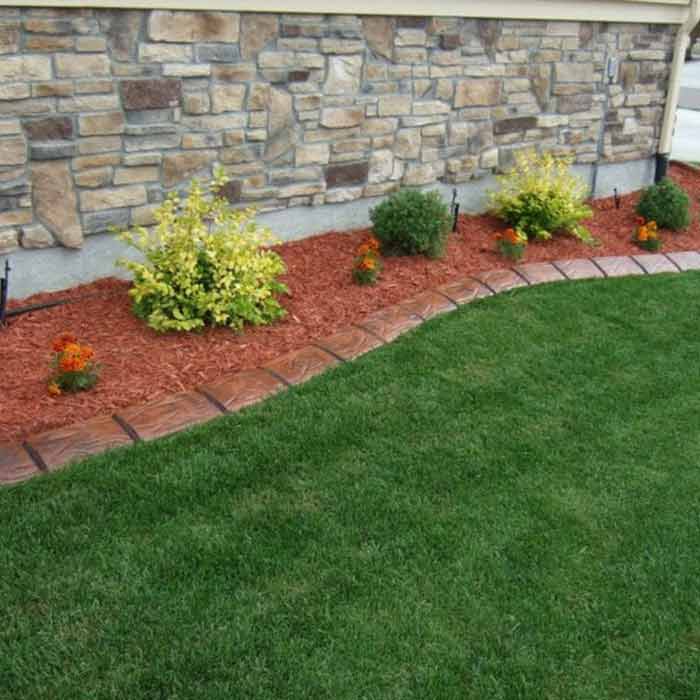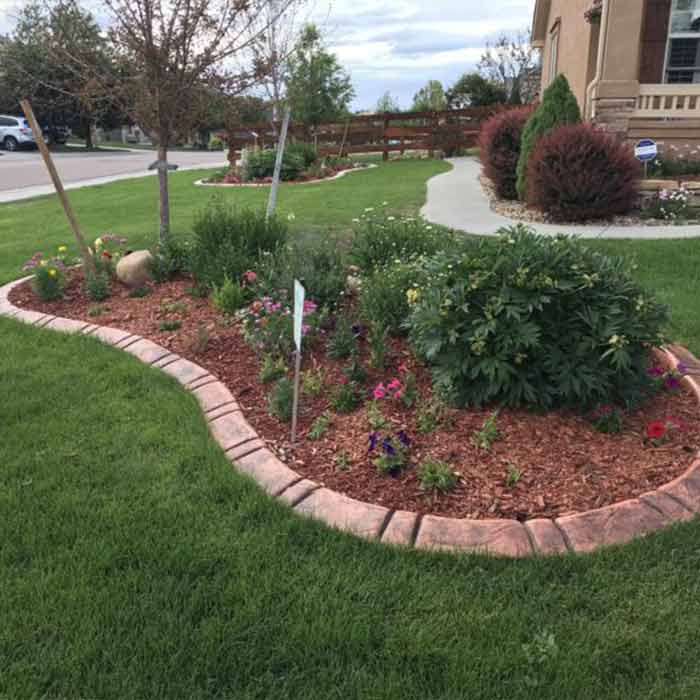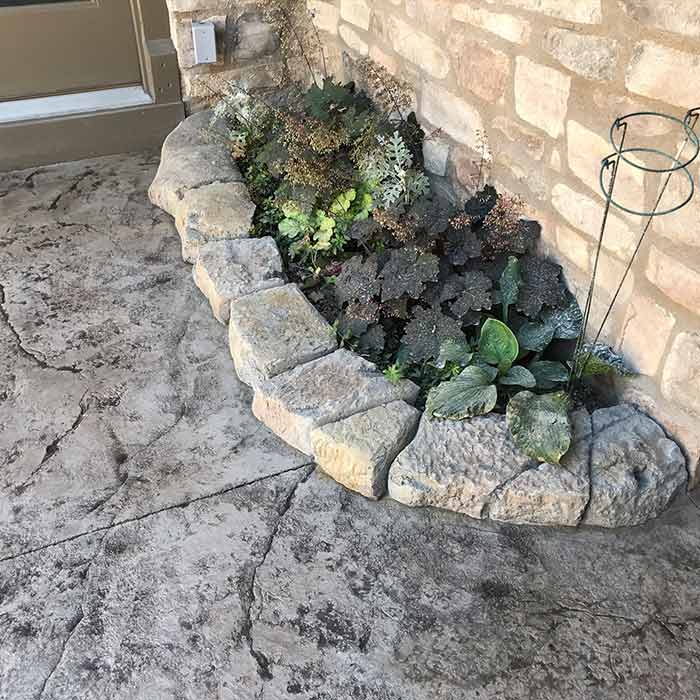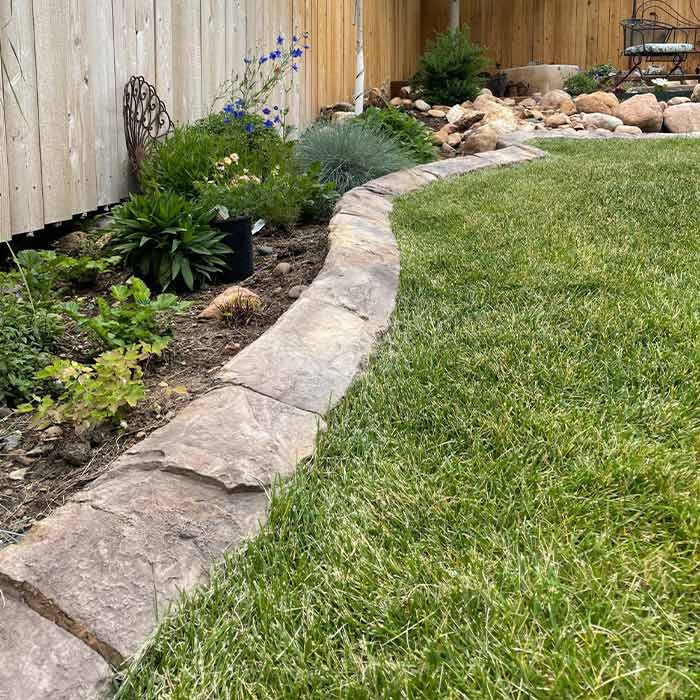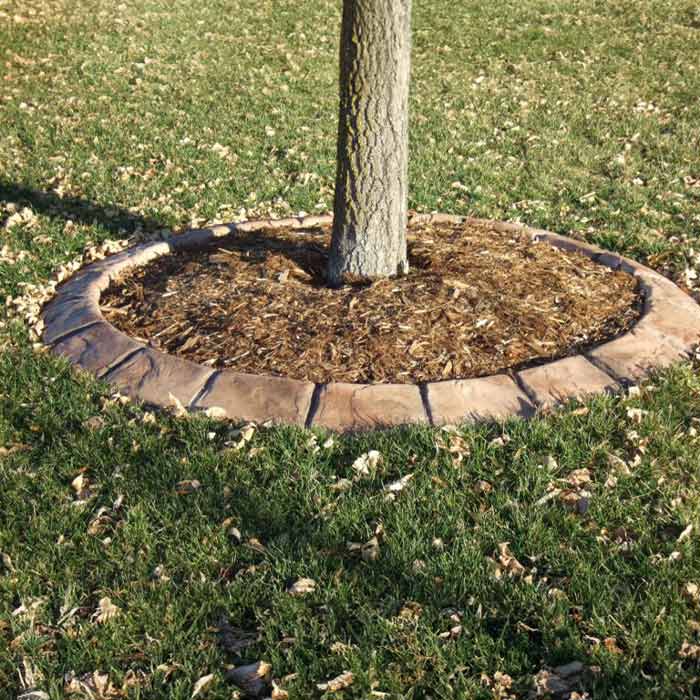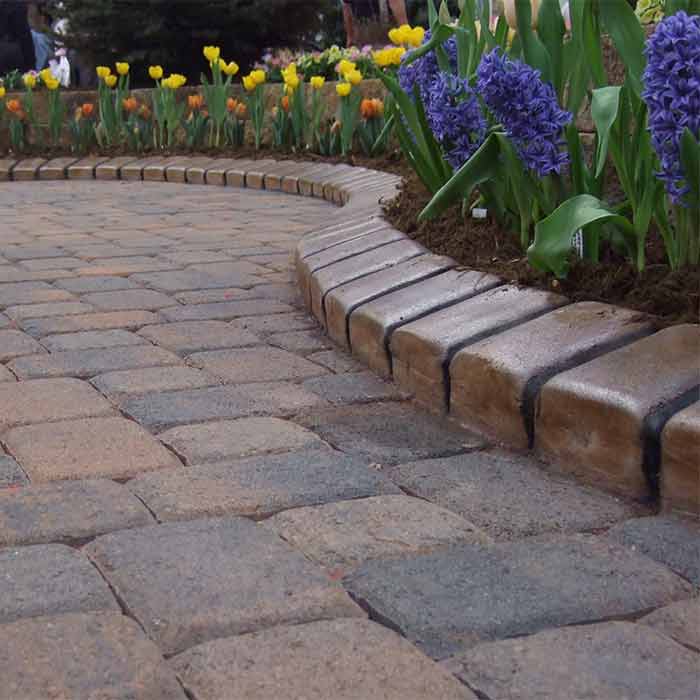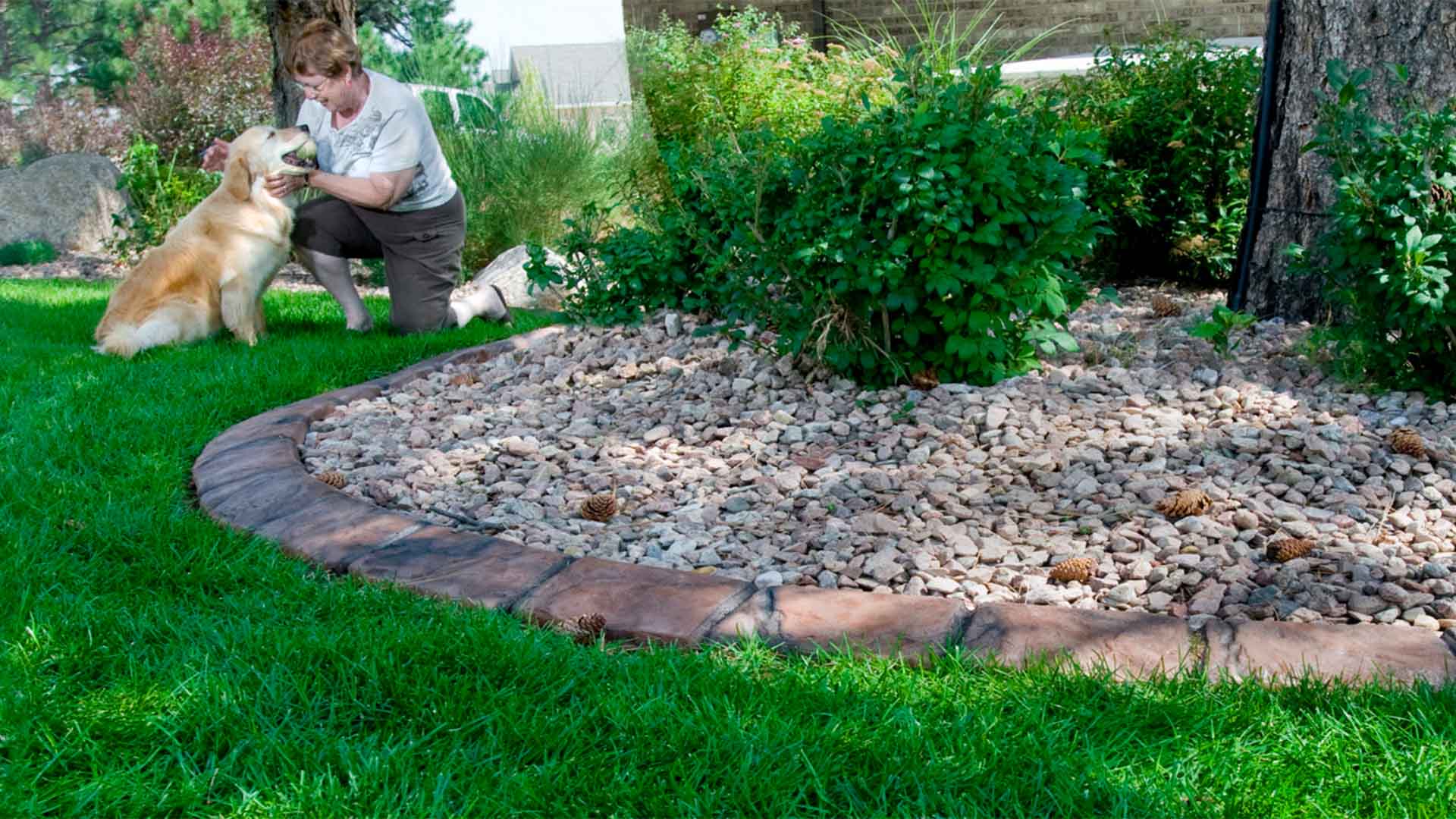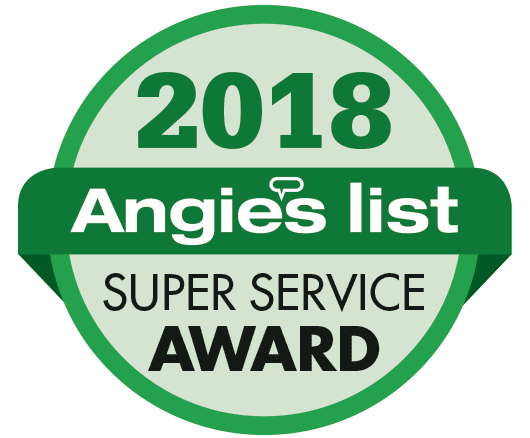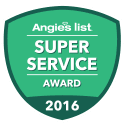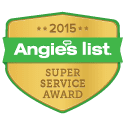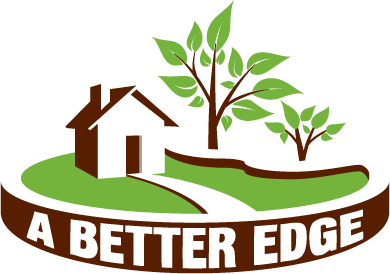The Evolution of Landscape Borders in the Centennial State
As a Colorado landscape professional with over 23 years of experience installing concrete curbing and landscape edging solutions, I’ve witnessed firsthand how landscape edging trends evolve with changing seasons and client preferences. In 2025, Colorado homeowners and businesses are embracing innovative approaches to landscape definition that balance aesthetics, durability, and environmental consciousness.
Let me walk you through the most significant landscape edging trends shaping Colorado’s outdoor spaces this year.
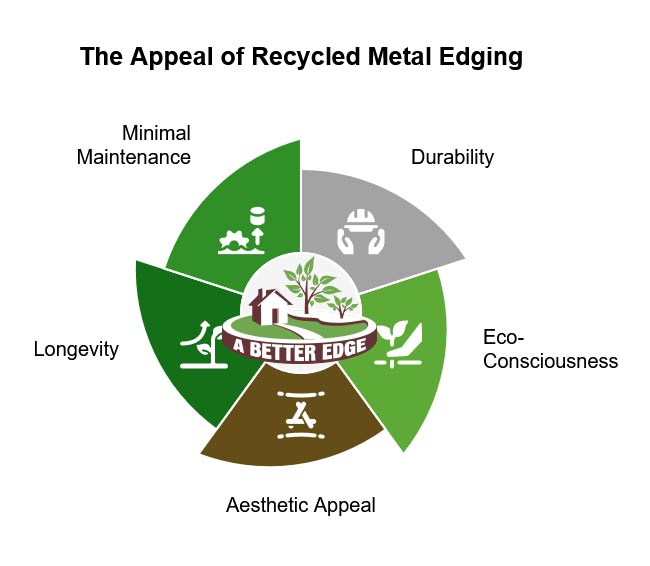
Sustainable Materials Leading Landscape Edging Trends
Recycled Metal Edging: Durability Meets Eco-Consciousness
One of the most prominent landscape edging trends 2025 is the surge in recycled metal options. Colorado homeowners are increasingly drawn to weathering steel (often called by the brand name Corten) for its rustic appearance that complements our mountain aesthetic.
These edging materials develop a protective rust-colored patina that:
- It blends beautifully with Colorado’s natural landscape
- Resists corrosion and weathering
- Provides exceptional longevity (20+ years in most applications)
- Requires minimal maintenance
The industrial-chic aesthetic of this metal edging pairs particularly well with xeriscaped yards and native plant gardens, which are both continuing to gain popularity in our water-conscious state.
Aluminum: The Lightweight Champion
Aluminum landscape edging has emerged as another frontrunner in 2025 landscape edging trends. Its popularity stems from several key advantages:
- Excellent flexibility for creating curved designs
- Its lightweight nature makes installation easier
- Superior durability with minimal maintenance required
- Resistance to rust and corrosion
- 100% recyclability at the end of life
For Colorado properties with complex landscape designs where no foot traffic will enter, aluminum has become a well used material for homeowners.
Traditional Materials with Modern Applications
Stone and Brick: Timeless Elegance Reimagined
While newer materials dominate many landscape edging trends, traditional stone and brick edging is widespread, particularly in neighborhoods with historical architecture. The difference in 2025 is how these materials are being used.
Material Type Comparison
| Material | Lifespan | Maintenance Needs | Average Cost per Linear Foot |
|---|---|---|---|
| Natural Stone | 50+ years | Low | $6 – $30 |
| Brick | 30-40 years | Moderate | $4 – $20 |
| Engineered Stone | 40-50 years | Low | $8 – $25 |
Colorado homeowners are increasingly opting for:
- Tumbled stone for a weathered, established look
- Irregularly shaped stone pieces for organic garden borders
- Reclaimed brick for environmentally conscious applications
- Dry-stacked stone walls doubling as seating areas
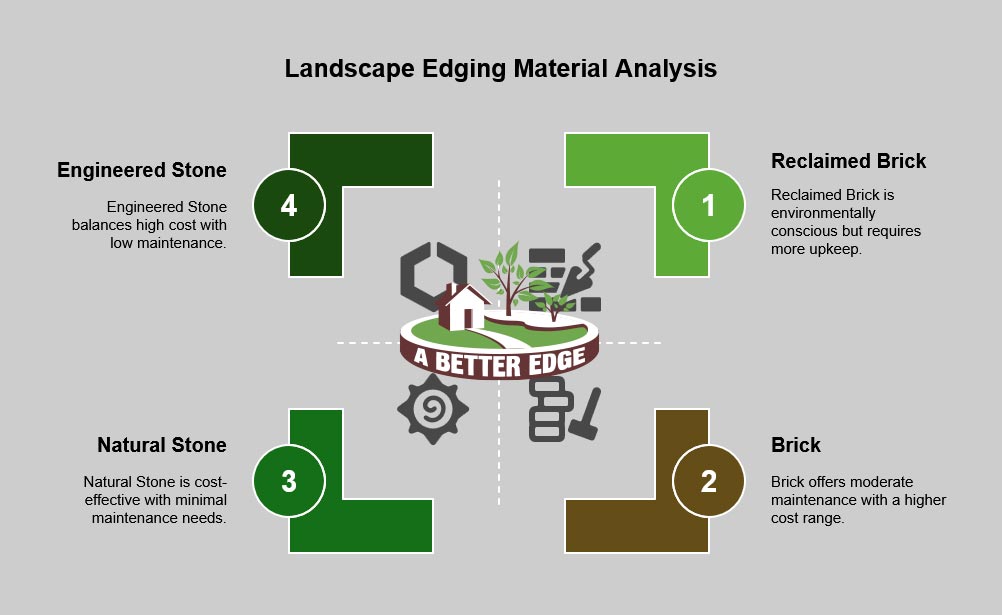
Concrete Edging: The Versatility Champion
Custom-poured concrete edging continues to be a staple in Colorado landscapes, with significant innovations in 2025. Discerning homeowners will see this rising landscape edging trend include:
- Integral coloring for a long-lasting, UV stability
- Hardeners and Staining for a more natural appearance
- Stamped patterns mimicking natural stone
- Curved and organic shapes rather than rigid lines
- Varied heights to create visual interest
- Various widths and shapes to accommodate intricate designs
Many homeowners are choosing concrete edging stamped and colored to resemble natural stone—gaining concrete’s durability and seamless installation benefits with the aesthetic appeal of more expensive materials combined with its superb pet and kid-friendly solutions.
Climate-Responsive Edging Solutions
Permeable Borders for Water Management
With Colorado’s increasingly unpredictable weather patterns, landscape edging trends focus on water management solutions. Permeable landscape borders that allow water to flow through rather than runoff are gaining significant traction.
These systems typically involve:
- Gravel-filled metal frame edging
- Permeable pavers as border elements
- Spaced stone or brick with drainage channels
- Concrete edging with integrated drainage cutouts
“In Colorado’s climate, effective water management isn’t just about conservation—it’s about protecting your property from erosion and storm damage. The right edging can make all the difference.” – Chad, Owner of A Better Edge
Freeze-Thaw Resistant Options
Colorado’s extreme temperature fluctuations present unique challenges for landscape materials. In 2025, landscape edging trends favor materials specifically designed to withstand our freeze-thaw cycles:
- Concrete formulations with air entrainment for freeze-thaw resistance
- Flexible edging systems that can move slightly with ground movement
- Deeply anchored metal edging to prevent frost heave
- Stone selections with low water absorption rates
- Brick installed over Concrete footers
Integration with Smart Landscape Technology
Illuminated Edging Systems
One of the most exciting landscape edging trends in 2025 is the integration of lighting elements. Colorado homeowners are embracing:
- Solar-powered LED strips integrated into edging
- LED puck lighting integrated into concrete edging
- Fiber optic lighting embedded in concrete borders
- Motion-activated pathway lighting for safety
- Color-changing options for seasonal displays
These illuminated borders enhance safety by marking pathway edges and extend outdoor living hours into the evening—a significant benefit for Colorado residents who cherish their outdoor spaces during our pleasant summer evenings.
Smartphone-Controlled Features
The integration of innovative technology with landscape elements extends to edging as well. The latest landscape edging trends include:
- Irrigation controls integrated with edging systems
- Temperature sensors that monitor frost conditions
- Lighting controls are accessible via smartphone apps
- Edging with built-in snow-melt capabilities for walkways
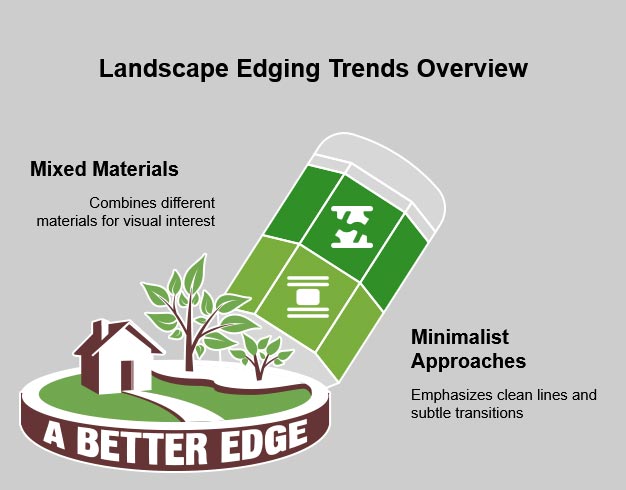
Design Trends in Landscape Edging
Minimalist Approaches
Many Colorado landscapes embrace minimalism in their edging choices, reflecting broader architectural trends. This landscape edging trend emphasizes:
- Clean, straight lines
- Monochromatic color schemes
- Flush installations that create subtle transitions
- Hidden fastening systems for seamless appearances
This approach, particularly popular in urban and suburban settings with contemporary architecture, creates sophisticated outdoor spaces that feel expansive and uncluttered.
Mixed Materials for Visual Interest
Conversely, another strong trend in landscape edging for 2025 is the intentional mixing of materials to create visual interest and texture. Colorado designers are combining:
- Concrete edging with stone accents
- Wood sections alternating with concrete
- Recycled glass aggregates embedded in concrete borders
- Living borders (plants) alongside hardscape elements
These combinations allow for creative expression while maintaining the functional benefits of durable edging materials.
Practical Considerations Driving Landscape Edging Trends
Low-Maintenance Requirements
With increasingly busy lifestyles, Colorado homeowners strongly prefer low-maintenance landscape solutions. This has significantly influenced landscape edging trends toward:
- Materials that don’t require regular painting or sealing
- Edging that prevents grass invasion effectively
- Systems that maintain their appearance with minimal cleaning
- Durable options that resist damage from lawn equipment
Cost-Effective Solutions
Economic considerations drive many landscape edging trends, with homeowners seeking the best value over time. The most popular approaches include:
- Modular systems that can be expanded over multiple seasons
- DIY-friendly installation options
- Materials with long lifespans that minimize replacement costs
- Multi-functional edging that combines borders with other features (seating, lighting, etc.)
Regional Variations in Colorado Landscape Edging Trends
Wood Edging Installation for Mountain Properties
- Measure and mark the area where edging will be installed
- Dig a trench deep enough to anchor wood planks securely
- Install and anchor with stakes
- Apply protective treatment to extend the lifespan
Front Range Urban Areas
Along the Front Range in Denver, Boulder, and Fort Collins, landscape edging trends skew toward:
- Contemporary metal edging in architectural styles
- Concrete edging with clean lines
- Integrated lighting systems
- Multi-functional borders that define outdoor living spaces
Western Slope Considerations
In Grand Junction and surrounding areas, landscape edging trends adapt to the arid climate:
- Xeriscaping-compatible edging systems
- Heat-resistant materials that won’t degrade in intense sun
- Water-channeling designs to maximize irrigation efficiency
- Desert-toned colors that complement the natural palette
Professional Installation Considerations
Custom vs. Pre-Fabricated Options
The balance between custom installation and pre-fabricated solutions significantly influences landscape edging trends. The market is increasingly divided between:
- Custom-poured concrete edging for perfectly tailored results
- Pre-fabricated sections for cost-effective installation
- Hybrid approaches using modular components with custom connections
- DIY-friendly systems for budget-conscious homeowners
Installation Pricing Factors
When considering landscape edging installation, Colorado property owners should understand the pricing variables:
| Material | DIY Cost per Foot | Professional Installation Cost per Foot |
|---|---|---|
| Concrete Edging | $8 – $45 | $16 – $35 |
| Rubber Edging | $6 – $16 | $15 – $25 |
| Natural Stone | $6 – $45 | $15 – $45 |
| Brick Edging | $4 – $20 | $12 – $30 |
Decorative Landscape Edging Trends
Artisanal and Custom Designs
For homeowners seeking truly unique landscapes, custom decorative edging represents a growing segment of landscape edging trends. Popular options include:
- Hand-carved stone borders (Choose artist carefully)
- Artist-designed metal edging with cutout patterns
- Mosaic-incorporated concrete edging
- Custom-stained concrete with personalized imprints
These bespoke options generally command premium prices but provide distinctive character to high-end landscapes.
Bold Geometric Patterns
Geometric designs continue to influence landscape edging trends, particularly in modern and contemporary landscape settings:
- Hexagonal pattern brick arrangements
- Angular metal edging with deliberate geometric breaks
- Alternating materials in rhythmic patterns
- Contrasting colors arranged in geometric sequences
Environmental Impact Considerations
Recycled and Upcycled Materials
Environmental consciousness continues to drive many landscape-edging trends in Colorado. Sustainable options gaining popularity include:
- Edging made from recycled plastic lumber
- Reclaimed brick and stone from demolition projects
- Repurposed metal from industrial sources
- Composite materials incorporating recycled components
Native Integration
Perhaps the most environmentally sensitive approach in landscape edging trends is the integration of native plants as living borders:
- Native grasses are used as transitional elements
- Low-growing Colorado native perennials as soft borders
- Rock gardens with native alpine plants
- Strategically placed boulders with native plant pockets
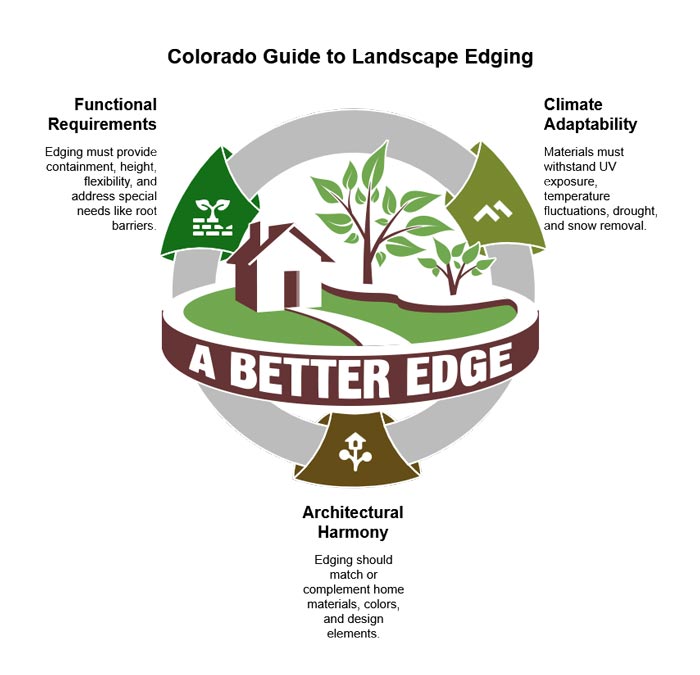
Choosing the Right Landscape Edging for Colorado Properties
When advising clients on landscape edging trends and selections, I consider several critical factors:
Climate Adaptability
Given Colorado’s unique climate challenges, edging materials must withstand:
- Intense UV exposure at our higher elevations
- Dramatic temperature fluctuations
- Periodic drought conditions
- Winter snow removal activities
Architectural Harmony
The most successful landscape edging complements existing architectural elements:
- Compliment materials or colors from the home’s exterior
- Echo design elements from the structure
- Consider the period and style of the property
- Create intentional contrast when appropriate
Functional Requirements
Beyond aesthetics, landscape edging trends must address practical needs:
- Containment strength for materials being retained
- Height requirements for specific applications
- Flexibility for curved vs. straight applications
- Special needs like root barriers or drainage considerations
Future Landscape Edging Trends on the Horizon
Biodegradable Temporary Options
For seasonal applications or temporary landscaping, biodegradable edging solutions are emerging as promising landscape edging trends:
- Compressed paper fiber edging for annual beds
- Compostable polymer-based flexible borders
- Woven natural fiber edging with a 2-3 year lifespan
- Plant-based bioplastic edging materials
Digital Customization
Looking slightly beyond 2025, emerging landscape edging trends point toward increased digital customization:
- 3D-printed concrete edging with completely customizable designs
- Digitally controlled bending for precise metal edge curvature
- Automated installation systems for perfect alignment
- Digital templating for complex landscape shapes
Conclusion: Making Informed Choices About Landscape Edging Trends
As Colorado’s landscapes evolve in 2025, the landscape-edging trends we’ve explored offer something for every property and preference. The options are more diverse than ever, from sustainable materials and innovative technology integration to regionally appropriate choices and artistic expressions.
When selecting landscape edging, consider current trends and the long-term value, maintenance requirements, and environmental impact of your choices. Proper edging enhances your landscape’s appearance and contributes to its functionality, sustainability, and longevity. Homeowners and businesses need highly consider the long-term visual effects and maintenance needs over the initial price.
For Colorado properties seeking the perfect balance of style, durability, and value, professionally installed concrete edging continues to offer exceptional results. It provides clean definition, endless design possibilities, and decades of performance with minimal maintenance.
By staying informed about landscape edging trends while considering your specific property needs, you can make choices that will enhance your outdoor spaces for years to come, regardless of how trends evolve.
For the minimal landscape requirements, visit the Landscape Ordinance page.
